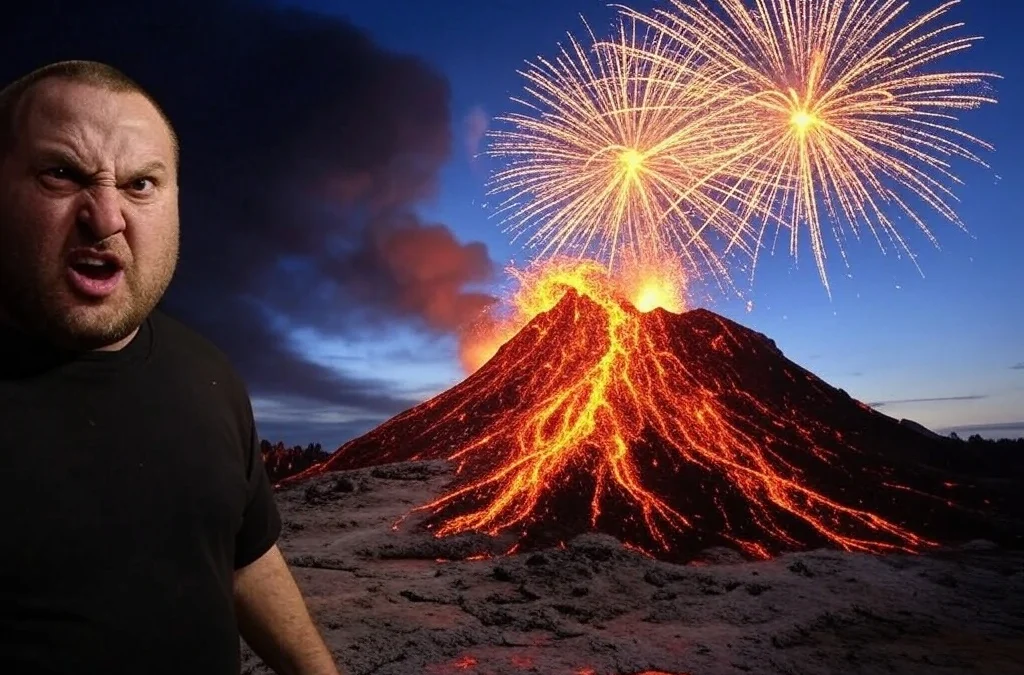The word “erupt” brings to mind powerful images of volcanoes spewing lava and ash into the sky. But eruptions happen in many forms beyond just volcanic activity. From emotional outbursts to social movements, from skin conditions to natural phenomena, the concept of eruption spans across numerous aspects of our world.
This article explores the fascinating concept of eruption in its many forms. We’ll look at what it means for something to erupt, examine various categories of eruptions, and provide insights into why eruptions occur. Whether you’re curious about natural eruptions, interested in understanding emotional eruptions, or simply want to expand your knowledge about this dynamic phenomenon, this comprehensive guide will enhance your understanding of all things that can erupt.
What Does It Mean to Erupt?
At its core, an eruption is a sudden, often violent release of pressure, energy, or material that was previously contained or suppressed. The word “erupt” comes from the Latin “erumpere,” which means “to burst out.”
For something to erupt, several elements are typically present:
- Buildup of pressure: Before an eruption, there’s usually an accumulation of force, energy, tension, or material.
- Containment: This pressure is temporarily held back or contained by some barrier or restraint.
- Breaking point: When the pressure exceeds what the containment can handle, a threshold is reached.
- Release: The sudden discharge of what was contained, often with considerable force.
- Observable aftermath: Eruptions typically leave evidence or consequences that can be observed after the event.
While volcanoes represent perhaps the most literal form of eruption, the concept extends to many other contexts. Emotions can erupt when feelings become too intense to suppress. Social movements erupt when collective frustration reaches a breaking point. Even some plants are described as “erupting” from the soil during rapid growth phases.
Top 50 Things That Can Erupt – Examples
Eruptions aren’t limited to volcanoes. Many things in nature, daily life, and society can erupt in powerful, sudden ways. Below are 50 diverse examples of what can erupt – each showing how the concept of eruption applies far beyond lava and ash.
1. Volcanoes:
Volcanoes are famous for erupting. They release lava, ash, and gas with enormous power. Eruptions can reshape landscapes and impact communities for years.
2. Emotions:
A sudden outburst of anger, joy, or sadness is an emotional eruption. We’ve all experienced times when strong feelings suddenly spill out, sometimes unexpectedly.
3. Champagne Bottle:
When opened, champagne can erupt with foam and bubbles. The sudden release happens because of trapped pressure, usually during celebrations.
4. Geysers:
Geysers erupt boiling water and steam into the air. Yellowstone’s Old Faithful geyser famously erupts regularly, attracting visitors from around the world.
5. Riots:
Riots erupt when groups of people suddenly become violent or chaotic. Often triggered by frustration or injustice, riots quickly escalate.
6. Fireworks:
Fireworks erupt into dazzling lights and colors in the sky. People gather to watch this beautiful but brief explosion of sparks during festivals or special events.
7. Laughter:
Laughter can erupt spontaneously, filling a quiet room with sudden joy. We’ve all experienced moments when laughter bursts out unexpectedly.
8. Arguments:
Arguments erupt when disagreements suddenly become heated. They often start calmly but quickly become intense, with raised voices and harsh words.
9. Applause:
Applause erupts when an audience spontaneously cheers and claps. It usually happens at the end of a moving speech or an impressive performance.
10. Storm Clouds:
Storm clouds erupt with lightning and thunder, releasing built-up electrical energy. The sudden sound and flash can startle anyone caught beneath.
11. Violence:
Violence can erupt suddenly in crowded areas or stressful situations. Often triggered by anger or fear, it creates chaos and danger rapidly.
12. Ideas:
Ideas can erupt suddenly in someone’s mind, leading to creativity or innovation. These flashes of inspiration can change lives or spark new projects.
13. Earthquakes:
Earthquakes erupt suddenly beneath the Earth’s surface, causing violent shaking. Buildings can collapse, and lives can be dramatically affected in moments.
14. Protests:
Protests erupt when large groups publicly voice anger or frustration. Though peaceful at first, protests can quickly escalate under certain conditions.
15. Oil Wells:
Oil wells can erupt uncontrollably if pressure beneath the ground isn’t managed. Such eruptions release oil and gas dangerously into the air.
16. News Stories:
Major news stories can erupt suddenly, grabbing public attention. Unexpected events, such as scandals or disasters, often trigger rapid media coverage.
17. Floodwaters:
Floodwaters can erupt suddenly after heavy rains or dam failures. Towns and cities may quickly become submerged, leading to dangerous situations.
18. Conflict:
Conflict between countries or communities can erupt suddenly, often after long-standing tension. Such eruptions might lead to war or serious disputes.
19. Pandemics:
Pandemics erupt when diseases spread rapidly around the world. COVID-19 erupted suddenly, affecting lives dramatically.
20. Water Pipes:
Water pipes can erupt when pressure becomes too great, causing leaks or bursts. Homeowners must then quickly address the sudden damage.
21. Gas Explosions:
Gas explosions erupt violently when gas leaks combine with sparks or flames. These eruptions can cause serious injuries and extensive damage.
22. Sneezes:
Sneezes erupt unexpectedly, releasing air and droplets from your nose. They often surprise both the sneezer and those nearby.
23. Crowd Cheers:
Crowds erupt with cheers during sports events when their favorite team scores. The sudden noise creates a thrilling atmosphere.
24. Sun Flares:
Solar flares erupt from the sun’s surface, sending intense energy toward Earth. These eruptions can disrupt satellites and power grids.
25. Popcorn Kernels:
Popcorn kernels erupt suddenly when heated. The explosion creates a tasty snack, popping in rapid succession.
26. Boiling Milk:
Milk can erupt from a pot if heated too rapidly. The frothy, sudden overflow can quickly create a kitchen mess.
27. Street Fights:
Street fights can erupt unexpectedly when tension between individuals escalates. These fights may attract attention and require quick intervention.
28. Pressure Cookers:
Pressure cookers can erupt dangerously if improperly handled. The sudden release of hot steam and contents is hazardous in the kitchen.
29. Soda Bottles:
Soda bottles erupt with foam if shaken before opening. Kids often enjoy causing this eruption, despite the sticky mess afterward.
30. Car Engines:
Car engines can erupt into flames when mechanical issues or leaks occur. Such eruptions pose serious danger and damage to vehicles.
31. Social Media Trends:
Social media trends erupt suddenly and spread rapidly online. Viral content or memes quickly capture attention around the globe.
32. Animal Attacks:
Animals, feeling threatened, can erupt suddenly into aggressive behavior. Such outbursts can happen unexpectedly, posing risks to people nearby.
33. Bullets from Guns:
Bullets erupt forcefully from guns when the trigger is pulled. This sudden explosion releases deadly force in milliseconds.
34. Angry Outbursts in Children:
Young children often erupt into tantrums when frustrated. Parents frequently deal with these sudden emotional outbursts.
35. Wildfires:
Wildfires erupt rapidly, often sparked by lightning or careless actions. These fires quickly spread, destroying homes and forests.
36. Acne (Pimples):
Pimples erupt on the skin unexpectedly, especially during teenage years. These eruptions are often unwelcome but common.
37. Road Rage:
Road rage erupts suddenly during driving disputes. Drivers’ frustrations can quickly escalate into aggressive or violent behaviors.
38. Water Balloon:
Water balloons erupt upon impact, splashing water suddenly. This playful eruption is common during hot summer days.
39. Laughing Fits:
Laughing fits erupt when something funny becomes uncontrollably hilarious. Friends often experience these joyful, spontaneous moments together.
40. Whistles from Boiling Kettles:
Tea kettles erupt into whistles when water boils. The loud whistle alerts you immediately that your water is ready.
41. Screams of Fear:
Fear can erupt suddenly into screams when someone is startled or frightened. Haunted houses often trigger these dramatic eruptions.
42. Misinformation:
False information can erupt online, spreading confusion quickly. People must be careful to verify facts before sharing.
43. Dust Storms:
Dust storms erupt rapidly, reducing visibility and causing chaos on roads. People caught in such storms find it hard to navigate safely.
44. Sudden Rainstorms:
Rainstorms erupt unexpectedly, drenching people without warning. These sudden downpours often surprise people without umbrellas.
45. Kitchen Fires:
Kitchen fires erupt swiftly when grease or food ignites unexpectedly. Such eruptions demand immediate attention.
46.Food Allergies:
Food allergies erupt suddenly in allergic individuals, causing rapid and severe reactions. Immediate medical care is essential in these situations.
47. Laugh Tracks on TV:
Laugh tracks on sitcoms erupt suddenly, signaling humorous moments. Viewers instinctively laugh along with the sudden outburst.
48. Appliances Short-Circuiting:
Electrical appliances can erupt into sparks if they malfunction. This sudden eruption signals potential danger.
49. Internet Outrage:
Outrage erupts quickly online when people react to controversial issues. Heated discussions and debates can flood social media rapidly.
50. Sudden Inspiration:
Creative inspiration erupts suddenly, sparking new ideas and solutions. Writers, artists, and inventors rely on these unexpected bursts to fuel their work.
Categories of Eruptions: What Can Erupt and Why?
Eruptions come in many forms. Some happen in nature, others in our bodies or societies. Here’s a look at the most common types of eruptions and what sets them apart.
Natural Physical Eruptions
These involve the physical release of matter or energy in natural systems:
- Volcanic eruptions
- Geysers
- Solar flares
- Gas vents in oceanic floors
- Seed pods explosively dispersing seeds
Biological Eruptions
These occur within or on living organisms:
- Skin conditions like rashes and acne
- Tooth eruption in developing children
- Plant shoots breaking through soil
- Population explosions in species
- Disease outbreaks
Emotional and Psychological Eruptions
These represent sudden releases of contained feelings or thoughts:
- Anger outbursts
- Fits of laughter
- Panic attacks
- Bursts of creativity
- Sudden realizations or epiphanies
Social and Cultural Eruptions
These involve collective human behaviors and movements:
- Protests and riots
- Cultural trends going viral
- Market bubbles and crashes
- Revolutionary movements
- Fashion crazes
Synonyms of “Eruption”
Here are some common and relevant synonyms for the word eruption, depending on the context:
-
Explosion
-
Outburst
-
Blast
-
Burst
-
Discharge
-
Breakout
-
Surge
-
Blowup
-
Flare-up
-
Escalation
-
Release
-
Detonation
-
Upheaval
-
Ejection
-
Emission
What Causes Eruptions?
Understanding the mechanics behind different types of eruptions reveals fascinating patterns and principles that connect seemingly unrelated phenomena.
Pressure Systems and Tipping Points
Most physical eruptions follow similar patterns of pressure buildup and release. In volcanic systems, magma accumulates beneath the Earth’s crust until pressure forces it upward. Similarly, geysers build steam pressure underground until it overcomes the weight of water above it.
This pressure-release mechanism has parallels in human systems too. Psychological research suggests that emotional eruptions often follow periods of stress accumulation. When our coping mechanisms can no longer contain the pressure, emotional eruptions occur as a form of release.
Energy Transfers During Eruptions
Eruptions represent dramatic energy transfers. During a volcanic eruption, potential energy stored in magma converts to kinetic energy as material is expelled, thermal energy as heat is released, and even sound energy in the form of eruption noises.
Social eruptions follow similar energy principles. Information, ideas, and emotions transfer rapidly through communities during social upheavals, creating cascading effects that can quickly transform societies.
Threshold Effects and Chain Reactions
Many eruptions involve threshold effects where a small change triggers a disproportionately large response. For example, a single social media post can sometimes trigger a massive viral trend, similar to how a small shift in tectonic plates can trigger a major volcanic event.
Chain reactions are common in eruption events. Forest fires spread from tree to tree, emotional outbursts in crowds can lead to mass panic, and disease outbreaks spread through populations through contact networks.
How to Predict Eruptions Before They Happen
Most eruptions give warning signs. There are various methods to predict, prepare for, and sometimes prevent eruptions across different domains.
Warning Signs and Precursors
Most eruptions give warning signs before they occur:
- Volcanic eruptions are often preceded by earthquake swarms, ground deformation, and changes in gas emissions
- Emotional eruptions may be preceded by increased irritability, physical tension, or withdrawal
- Social eruptions are frequently foreshadowed by increasing expressions of discontent, smaller demonstrations, or growing online activity
- Skin eruptions may be preceded by inflammation or sensitivity in affected areas
Recognizing these warning signs can help prepare for or sometimes prevent the full eruption.
Mitigation Strategies
Different types of eruptions require different management approaches:
For natural eruptions:
- Evacuation plans and early warning systems for volcanic regions
- Controlled burns to prevent forest fire eruptions
- Engineering solutions like pressure relief wells for geothermal areas
For emotional eruptions:
- Stress management techniques
- Mindfulness practices
- Therapy and counseling
- Communication skills training
For social eruptions:
- Community dialogue platforms
- Policy reforms addressing underlying issues
- Conflict resolution mechanisms
- Transparent communication from authorities
For biological eruptions:
- Preventive healthcare
- Quarantine protocols for disease outbreaks
- Proper skincare regimens
- Vaccination programs
The Impact of Eruptions
Eruptions of all kinds can have profound and lasting effects on their surroundings, though these impacts vary greatly in scale and nature.
Transformative Power
Eruptions often act as catalysts for transformation:
Volcanic eruptions create new landforms and eventually lead to some of the most fertile soils on Earth. The 1980 eruption of Mount St. Helens devastated the surrounding landscape but also created opportunities for ecological succession and scientific study of recovery processes.
Social eruptions like the Civil Rights Movement transformed American society and laws. The Arab Spring eruptions reshaped political landscapes across multiple countries.
Personal emotional eruptions, while sometimes destructive in the moment, can lead to important conversations, boundary-setting, and relationship recalibrations that might not otherwise occur.
Short and Long-term Consequences
Eruptions have both immediate and delayed effects:
Short-term:
- Destruction and disruption
- Release of built-up tension
- Visibility of previously hidden issues
- Immediate responses from surrounding systems
Long-term:
- New growth and regeneration
- Systemic adaptations
- Cultural memory and preparation for future events
- Evolution of more resilient systems
The 79 CE eruption of Mount Vesuvius had the immediate consequence of destroying Pompeii but has provided invaluable archaeological insights thousands of years later. Similarly, market crashes cause immediate pain but often lead to regulatory reforms that strengthen financial systems long-term.
Conclusion
Eruptions, whether they occur in nature, within our bodies, in our emotional lives, or across societies, follow remarkably similar patterns of pressure buildup and release. They remind us of the dynamic, ever-changing nature of our world and ourselves.
By understanding what causes different types of eruptions, recognizing their warning signs, and developing appropriate response strategies, we can better navigate these powerful events. Sometimes we need to prevent eruptions, sometimes we need to channel them productively, and sometimes we simply need to respect their force and move to safety.
The next time you encounter an eruption—whether it’s a news story about a volcanic event, an emotional outburst from a loved one, or a viral trend erupting across social media—you’ll have a deeper appreciation for the complex forces at work and the fascinating connections between seemingly different eruption phenomena.
The Most Popular on BitGlint

Top 100 Personal Items List
Everyone uses personal items in their daily lives, often without even thinking about them. From the moment you wake up...

30 Defiance Examples & Meaning
Defiance is something most people experience at some point in life. You feel it when you say no to something that...

Top 30 Desire Examples & Definition
Desire is a powerful force that drives much of human behavior, shaping our goals, dreams, and everyday decisions. It's...

100 Non-Digital Things List
In everyday life, there are still hundreds of objects, tools, and materials that exist completely outside the digital...

30 Examples of Attention & Definition
Have you ever noticed how a catchy tune can grab your attention, even when you're busy doing something else? It's...

60 Cultural Traditions Examples & Definition
Cultural traditions are part of daily life - whether people realize it or not. They shape what we eat, how we...

Top 30 Intimacy Examples & Meaning
Intimacy goes beyond physical touch or romantic moments. It’s about closeness, trust, and connection. In everyday...
Get Inspired with BitGlint
The Latest
40 Emotional Value Examples & Meaning
Why do some messages stick — while others are forgotten? Why do people choose one brand over another, even when the product is the same? The answer often comes down to emotional value. Emotional value is what makes a message feel human. It’s the emotional connection...

30 Teasing Examples & Definition
Teasing is a common part of human interaction. People tease in different ways, for different reasons. Sometimes it is friendly. Sometimes it can hurt feelings. Understanding what teasing means and seeing clear examples helps everyone handle these moments better....
40 Thought Experiments for Curious Minds
Some questions can’t be answered with a simple yes or no. Some problems don’t have a clear solution. That’s where thought experiments come in. They aren’t just old ideas from philosophy books. Thought experiments are tools we still use to think through problems, test...
30 Oligarchy Examples & Definition
Have you ever felt like a small group of people secretly runs everything—whether in politics, business, or even everyday life? You’re not alone. Throughout history, power has often ended up in the hands of a few, shaping governments, economies, and societies in ways...

